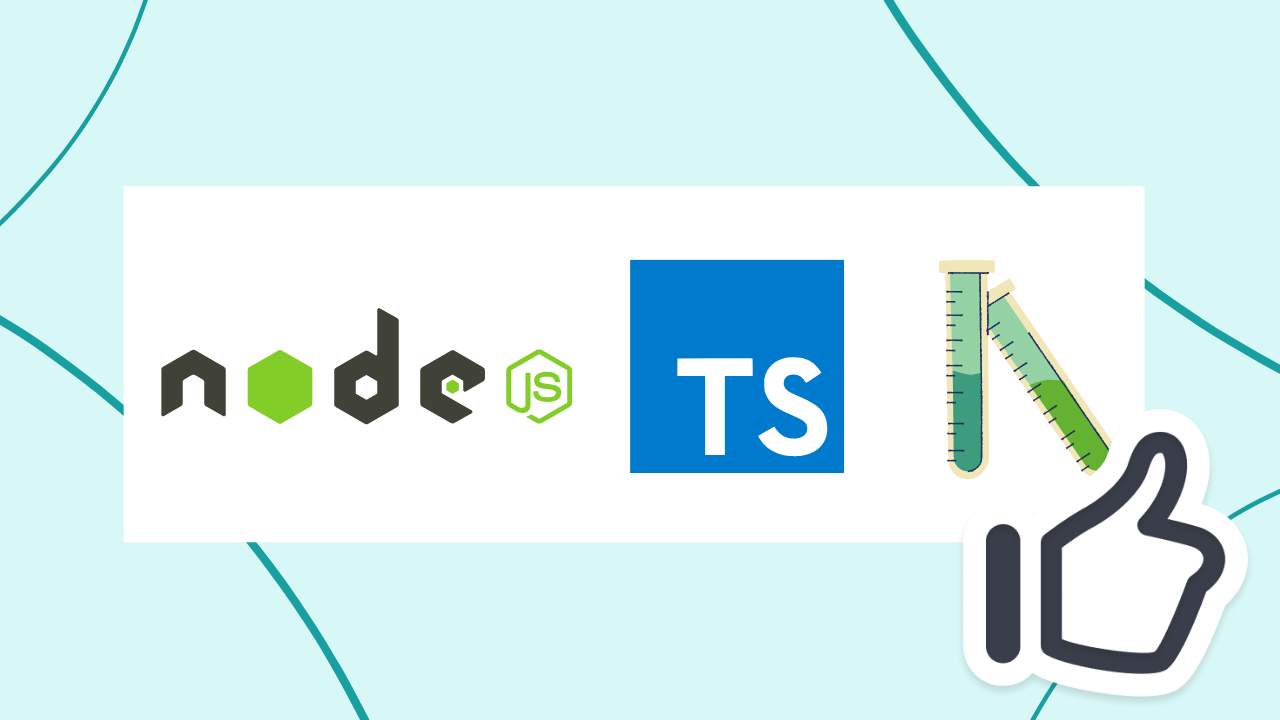Hello Guys!
I'm really excited for this post, today we're going to learning how to test an API with TDD and use typescript in nodejs especially if you are a beginner, so this article will be very technical. Prepare the coffe and open vscode!

Before you start you need the following tools:
With the tools in hand, now just get your hands dirty.
⚫ What is TDD?
Going straight to the point TDD (Test-driven development) is a methodology to write the tests first for a given module/business rule and for the actual implementation after.
The TDD is a 3-step process:
- Developers implement the project requirements and specific test cases;
- The test cases fail because the developers have not yet written the code;
- The developers write the code to pass the tests;
If you have never used. I hope this article will motivate you to use it, why is it sensational!

🏳️ Project context
We will create an api of todo list.
This project is 100% focused on testing, here not we will learn about JWT, datebase configuration, security etc.
Functionalities:
- ✅ User can list them all;
- ✅ User can create a whole;
- ✅ User can filter a whole by id;
- ✅ User can delete a whole;
- ✅ User can update a whole;
A while ago I made a post of How to create front-end tests in ReactJs in case you are also interested in testing your front!
📚 Models
Here are the models of how the date should return in JSON.
{ "id": "", "task": "", "status": "" }
📍 Routes
Here you will get the view of the routes we will create in our back-end.
[GET] api/todo - View all todos
[GET] api/todo/:id - Search by id
[POST] api/todo - Save new todo
[PUT] api/todo - Update todo
[DELETE] api/todo/:id - Delete todo
Great, now we have everything we need to create our api. Let's put our hand in the code!
⭐ Starting the project
To start the project and very simple, make sure you are using npm ok?
mkdir node-todos-testing cd node-todos-testing npm init
💻 Installing the dependencies
npm install --save typescript @types/express express body-parser nodemon
📢 Setting up TypeScript
In the project root create a file called tsconfig.json and put the following code block
{ "compilerOptions": { "module": "commonjs", "esModuleInterop": true, "target": "es6", "noImplicitAny": true, "moduleResolution": "node", "sourceMap": true, "outDir": "dist", "baseUrl": ".", "paths": { "*": ["node_modules/*"] } }, "include": ["src/**/*", "__tests__/**/*"], "exclude": ["node_modules", "dist"] }
We will also create the nodemon.json configuration file for him to understand our .ts files
{ "ignore": ["**/*.test.ts", "**/*.spec.ts", ".git", "node_modules"], "watch": ["src"], "exec": "npm run dev:server-debug", "ext": "ts" }
Now let's create the src project structure and file app.ts but let's leave this file blank initially ok?
. ├── node_modules ├── nodemon.json ├── package-lock.json ├── package.json ├── src │ ├── app.ts └── tsconfig.json
Now we will install some more dependencies for the tests and perform our first test!
- Jest
- ts-jest (Um pré-processador TypeScript com suporte a mapa de origem para Jest que permite usar Jest para testar projetos escritos em TypeScript.)
- supertest, Biblioteca HTTP
- Jest types
- supertest types
npm i -D jest ts-jest supertest @types/jest @types/supertest
Next, add another configuration file for Jest: jest.config.js
module.exports = { preset: 'ts-jest', testEnvironment: 'node', }
After adding the test script to ./package.json:
{ ... "scripts": { ... "test": "jest", ... }, ... }
Create one more folder in the root of the __test__ project and call our src/app file remembering that this file is blank!
But now let's add code to it. Let's review our project structure, make sure it looks like yours.
. ├── __tests__ │ ├── app.test ├── node_modules ├── nodemon.json ├── jest.config.js ├── package-lock.json ├── package.json ├── src │ ├── app.ts └── tsconfig.json
UFAAAA! Now we can write our first test \o

In the app.test file we will add a hello world endpoint, to see if everything is working.
import { newApp } from "../src/app" import request from "supertest" const app = newApp() describe("Test public routes", () => { it("should respond with a 200 response and a 'Hello World' body in / ", () => { return request(app).get("/").expect(200, "Hello World!") }) })
Probably the first import will be in error, we will add the following code to the src/app file
import express from "express" import { Express } from "express" export function newApp(): Express { const app = express() app.get("/", (_, res: express.Response) => { res.send("Hello World!") }) return app }
If we execute the command at the terminal: npm test
You must have something like this in your terminal:
PASS __tests__/app.test.ts Test public routes ✓ should respond with a 200 response and a 'Hello World' body in / (32 ms) Test Suites: 1 passed, 1 total Tests: 1 passed, 1 total Snapshots: 0 total Time: 1.055 s
Now we need to refactor our app file, transform it into class', and add ourrouter' files
New file route.ts
import express from "express"; export class Routes { app = express(); public routes(app: any): void { app.get("/", (_: any, res: express.Response) => { res.send("Hello World!"); }); } }
app.ts
import * as bodyParser from "body-parser"; import express from "express"; import { Routes } from "./routes"; class App { public app: express.Application; public routePrv: Routes = new Routes(); constructor() { this.app = express(); this.config(); this.routePrv.routes(this.app); } private config(): void { this.app.use(bodyParser.json()); this.app.use(bodyParser.urlencoded({ extended: false })); this.app.set("json spaces", 2); } } export default new App().app;
app.test.ts
import app from "../src/app" import request from "supertest" describe("Test public routes", () => { it("should respond with a 200 response and a 'Hello World' body in / route", () => { return request(app).get("/").expect(200, "Hello World!") }) })
If you run the npm test
You will have the same return of success!
Sensational, right?
Now let's create one more test that returns the list of all:
app.test.ts
import app from "../src/app" import request from "supertest" describe("Test public routes", () => { it("should respond with a 200 response and a 'Hello World' body in / route", () => { return request(app).get("/").expect(200, "Hello World!") }) it("should respond with a 200 response and a list todos body in /todos route", async () => { const res = await request(app).get("/todos") expect(res.status).toEqual(1) expect(res.body).toHaveLength(1) }) })
If you run npm test you will get the following feedback:
FAIL __tests__/app.test.ts Test public routes ✓ should respond with a 200 response and a 'Hello World' body in / route (22 ms) ✕ should respond with a 200 response and a list todos body in /todos route (7 ms) ● Test public routes › should respond with a 200 response and a list todos body in /todos route expect(received).toEqual(expected) // deep equality Expected: 200 Received: 404 9 | it("should respond with a 200 response and a list todos body in /todos route", async () => { 10 | const res = await request(app).get("/todos"); > 11 | expect(res.status).toEqual(200); | ^ 12 | expect(res.body).toHaveLength(1); 13 | }); 14 | }); at __tests__/app.test.ts:11:24 at fulfilled (__tests__/app.test.ts:5:58) Test Suites: 1 failed, 1 total Tests: 1 failed, 1 passed, 2 total Snapshots: 0 total Time: 2.346 s, estimated 3 s Ran all test suites. npm ERR! Test failed. See above for more details.
If you run npm test you will get the following feedback:
routes.ts
import express from "express"; const todos = [ { id: "1", task: "Go to the gym", status: "OK", }, ]; export class Routes { app = express(); public routes(app: any): void { app.get("/", (_: any, res: express.Response) => { res.send("Hello World!"); }); app.get("/todos", (_: any, res: express.Response) => { res.send(todos); }); } }
If you run npm test you will get the following feedback:
PASS __tests__/app.test.ts Test public routes ✓ should respond with a 200 response and a 'Hello World' body in / route (21 ms) ✓ should respond with a 200 response and a list todos body in /todos route (5 ms) Test Suites: 1 passed, 1 total Tests: 2 passed, 2 total Snapshots: 0 total Time: 0.931 s, estimated 3 s Ran all test suites.
YEAHHHH!
Now let's follow the whole flow: First the test, then implementation, as we did in the example above!
Initially it will be a problem, but we will adapt in the middle of the development, this is TDD!
The complete test file will look like this!
I created a TaskType.ts file
export type Task = { id?: string, task?: string, status?: string, }
routes.ts
import express from "express"; import { Task } from "./TaskType"; let todos = [ { id: "1", task: "Go to the gym", status: "OK", }, ]; export class Routes { app = express(); public routes(app: any): void { app.get("/", (_: any, res: express.Response) => { res.send("Hello World!"); }); app.get("/todos", (_: any, res: express.Response) => { res.send(todos); }); app.get("/todo/:id", (req: express.Request, res: express.Response) => { const { id } = req.params; todos = todos.filter( (task: Task) => task.id.toString() !== id.toString() ); res.json(todos); }); app.post("/todo", (req: express.Request, res: express.Response) => { const task = req.body; todos.push(task); res.json(todos); }); app.put("/todo", (req: express.Request, res: express.Response) => { const taskToUpdate = req.body; todos = todos.map((task: Task) => task.id === taskToUpdate.id ? { ...task, ...taskToUpdate } : task ); res.json(todos); }); } }
app.test.ts
import app from '../src/app' import request from 'supertest' import { Task } from '../src/TaskType' describe('Test public routes', () => { it("should respond with a 200 response and a 'Hello World' body in / route", () => { return request(app).get('/').expect(200, 'Hello World!') }) it('should respond with a 200 response and a list todos body in /todos route', async () => { const res = await request(app).get('/todos') expect(res.status).toEqual(200) expect(res.body).toHaveLength(1) }) it('should create new task in /todo route', async () => { const task: Task = { id: '2', task: 'Learning IA', status: 'NOT', } const res = await request(app).post('/todo').send(task) expect(res.status).toEqual(200) expect(res.body).toHaveLength(2) }) it('should update a task in /todo route', async () => { const taskToUpdate: Task = { id: '2', task: 'Learning IA', status: 'OK', } const res = await request(app).put('/todo').send(taskToUpdate) const todos = res.body const obj = todos.find( (task: Task) => task.id.toString() === taskToUpdate.id.toString() ) expect(res.status).toEqual(200) expect(res.body).toHaveLength(2) expect(obj.status).toBeTruthy() }) it('should return a task in /todo:id route', async () => { const res = await request(app).get(`/todo/${1}`) expect(res.status).toEqual(200) expect(res.body).toHaveLength(1) }) })
Tests created! Now you have more security to change the code and implement new business rules.
PASS __tests__/app.test.ts Test public routes ✓ should respond with a 200 response and a 'Hello World' body in / route (22 ms) ✓ should respond with a 200 response and a list todos body in /todos route (6 ms) ✓ should create new task in /todo route (22 ms) ✓ should update a task in /todo route (4 ms) ✓ should return a task in /todo:id route (3 ms) Test Suites: 1 passed, 1 total Tests: 5 passed, 5 total Snapshots: 0 total Time: 2.241 s, estimated 3 s Ran all test suites.
The source code you find here!
Thanks for your time!


